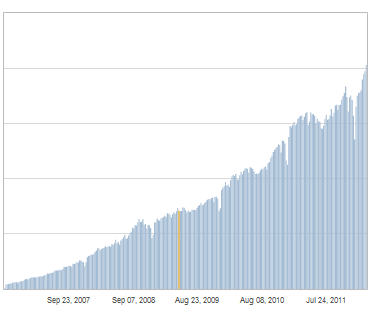
If not familiar with Crowdsourcing, I’m not surprised. While it’s one of the greatest revolutions in web services in the past few years, the concept has gone largely unnoticed due to the many disparate uses for leveraging the wisdom of the crowds.
According to the crowdsourcing experts at chaordix, crowdsourcing is “a way of engaging groups of people to submit, discuss, refine and rank ideas and submissions for a specific question posed by an organization. The crowd may be citizens, consumers, employees, partners or others. The resulting high value information can be a greater understanding of market needs and preferences, a new product idea or enhancement, or a discovery of a solution to a difficult to solve problem. For success, crowdsourcing requires a combination of online technology and human collaboration know-how, a clear purpose and an engaged crowd.”
Simply, there are people smarter and better than you at something; the internet brings us together and enables collaboration and efficiency.
The Crowdsourcing Pioneers
There are a few brands with which you might be familiar; web companies that innovated online technology in ways that brought crowdsourcing mainstream.
- oDesk – The oldest crowdsource service with which I’m familiar, oDesk manages remote work teams for your project or organization. Bringing together developers, programmers, business professionals, and designers, you can leverage oDesk to build a company run by freelancers around the world.
- threadless – A personal favorite, threadless brings together designers, critics, and apparel, creating a store with fantastic shirts you won’t find any where else in the world. Any one can contribute a design or slogan, the crowd contributes their opinions, and threadless makes it happen. I submitted a slogan once, “Once I thought I was wrong but I was mistaken” but, recognizing that my talents as a graphic designer pale in comparison to the pros on threadless, can’t fault them for leaving my suggestion in the dust bin.
- Crowdspring – With graphic design skills so poor, I turn to Crowdspring with most of my ideas. Crowdspring connects you with thousands of designers to bring your direction to life. Where the service really excels is when you have a vague idea of what you need and could use a creative community far more experienced than you to share some possibilities. When you find the design(er) that works, they put you in touch to finish off your project and pay the bill.
The Crowdsourcing Revolutionaries
With the foundation established, entrepreneurs ran with the possibilities, creating an exceptional diversity of services to which you can turn to get things done more efficiently, more quickly, and more professionally than you could do on your own.
- Fox Translate – The lead for my story really planted the recognition of this trend in my head, their work with document translation is making it easy and inexpensive for anyone to get accurate, certified translations; perhaps more importantly, it’s employing people around the world who can offer translation services before only remotely available by phone, mail, or in your community. Dealing primarily in immigration documents, Fox Translate returns to you in almost no time, a certified translation of a document; addressing the tremendous demand for certificates, licenses, transcripts, passports, and other paperwork that we increasingly need in other languages to support our work across borders and cultures.
- Quirky – Is anything but quirky; though it’s products often fit the bill. Think of Quirky as threadless for inventors. As much as uncommon goods has become one of my go to shopping sites for unique gifts you won’t find manufactured for a big box store, Quirky is where I turn for every birthday and holiday for that something really special. It’s the one place where you’ll spend your day just browsing the merchandise, all while thinking, “why didn’t I think of that?” or “that’s exactly what I need!” Users submit ideas which are then vetted and molded by the community. Quirky picks the fan favorites and makes them a reality. From electronics to travel gear, housewares to toys, Quirky is crowdsourcing the mother of invention. (I misspoke just a bit, the demand for Quirky is growing so significantly that the big box stores want a piece of the creativity)
- Kickstarter – If you’ve spent any time working with startups or trying to raise capital, you know that the venture community can be fickle and friends and family… well… Kickstarter is solving that, connecting anyone with money to everyone with an idea and a plan. Fashion, film, software, and music span just a few of the types of projects started Kickstarter; where you can become a patron of a great idea or find the capital to get yours off the ground.
- Quora – Question and answer sites are hardly new but Quora has evolved the crowdsourced model to something sustainable and meaningful. Where QA sites before, fraught with spam, simply minded answers, and a light atmosphere, have failed to retain people, Quora crowdsources not just the answers but moderators. Inaccurate answers and even poor responses are reviewed and if necessary addressed (by everyone); questions are edited before your eyes to make them clearer and unbiased; and the engaged community is genuinely interested in offering their expertise and experience. I’m a fairly heavy contributor so following me there is a great way to stay on top of tips and tricks I’ve shared with others.
- PatientsLikeMe – The last that has caught my attention is PatientsLikeMe; a site for those unconcerned about the media’s scare-mongering over medical privacy. Many believe that greater transparency to your medical history can only be better for you. If not in the best interest of doctors or pharmaceutical companies, being open about the things that keep you up at night helps you connect with others in similar circumstances. Find the best doctors for your particular maladies while evaluating medicines and treatments with other patients rather than the marketing engines fueled by billions in pharma ad budgets. Granted, sharing your history and using a free service certainly opens you up to targeted advertising. But then, if I see another ad for Erectile Dysfunction treatments I’m going to scream (at least until I need it).
There was a great post I read just a few weeks ago from Tim Berners-Lee (inventor of the Internet – really!) in Scientific American. His point was to address the constraints being placed on the web by the likes of Facebook; a simple premise and concern that many web services are creating closed environments where you lose control and ownership of your data (a perspective I’ve covered before).
Bringing my tangent back this piece about crowdsourcing, what I had never considered before but what Tim clarified in his article is that there is a difference between the “Web” and the “Internet.” His Internet is just a collection of connected computers (he puts it much more elegantly than that); what the Internet promises is connectivity and openness. On the other hand, the Web is a construct on the Internet; it’s what we create and control. In many cases, unfortunately, many entrepreneurs are ignoring the tenants of the internet for profit on the web. Think back to how well a closed experience worked for AOL and consider where you stand on the debate because it’s a serious one dealing with everything from privacy and net neutrality to, well, crowdsourcing.
Keep connecting!


